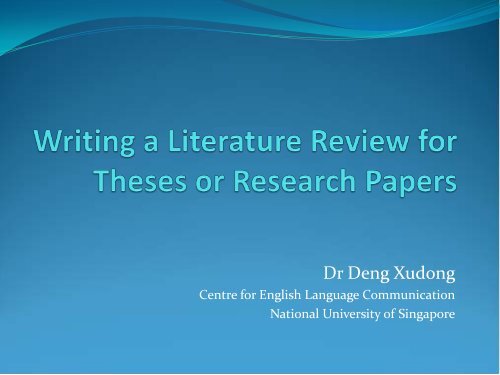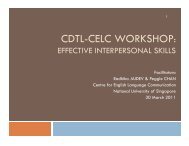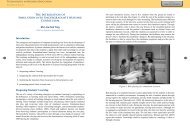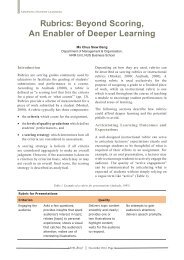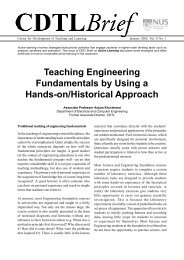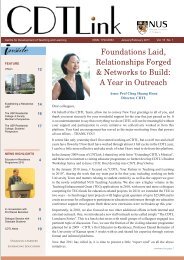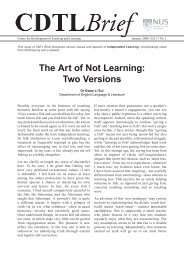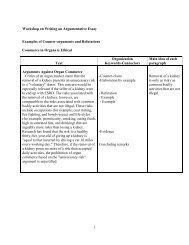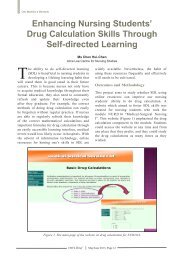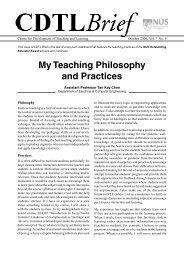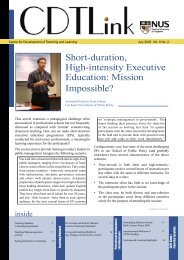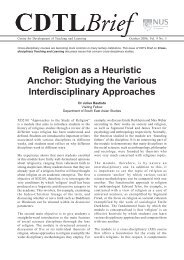Reading Materials - CDTL - National University of Singapore
Reading Materials - CDTL - National University of Singapore
Reading Materials - CDTL - National University of Singapore
- No tags were found...
You also want an ePaper? Increase the reach of your titles
YUMPU automatically turns print PDFs into web optimized ePapers that Google loves.
Dr Deng XudongCentre for English Language Communication<strong>National</strong> <strong>University</strong> <strong>of</strong> <strong>Singapore</strong>
Writing LR: Questions1. Have you written a literature review before?2. When you read a paper, do you read theliterature review section? Why or why not?3. Who do you think will be the readers foryour literature review?4. Can we do without a literature review?Why or why not?5. When do we write our literature review?
Understanding about reviewTrue or False1. The preparation <strong>of</strong> a literature review is a three-stepprocess: finding the relevant literature, reading, andthen writing up the review.2. Your literature review should be as long as possibleto persuade your reader that you have read verywidely.3. Your literature review should discuss problemsand/or controversies within your field.
Understanding about review4. Your literature review should help you reveal gaps inthe existing body <strong>of</strong> research.5. Your literature review should be presented inchronological order.6. Your literature review is important because itdemonstrates that the findings, theory, or analysisthat you will present are a contribution to acumulative process.
If I can see further it is because I amstanding on the shoulders <strong>of</strong> giants.-Isaac NewtonType any name to tag:
Today’s agendaTypical contentStructural elementsOrganizationCitation practicesParaphrasing techniquesMaintaining continuity <strong>of</strong> ideas
What needs to be included in LR?• Key issues underlying the researchproject• Major findings on the topic• Main points <strong>of</strong> views andcontroversies surrounding the issuebeing investigated• Critical evaluation <strong>of</strong> these views• General conclusions about the state<strong>of</strong> the art
Strategies for writing a LR• Search• Read• Prepare to write• Write• Indicate the gap
Overall StructureIntroductionBody [modular move structures]Theme-bound Move structure 1Theme-bound Move structure 2Theme-bound Move structure 3*ConclusionSummarizing the gist
A thesis exampleChapter 3 Literature review on overlap and listener response1. Introduction 692. Studies on overlap 692.1 Characterization <strong>of</strong> overlap 702.2 Classification <strong>of</strong> overlap 782.3 Cross-cultural study <strong>of</strong> overlap 1092.4 Gender-differentiated use <strong>of</strong> overlap 1152.5 Summary and conclusion 1173. Studies on listener response 119…
Example <strong>of</strong> a review articleListener Response1. Introduction2. Approaches to the study <strong>of</strong> listener responses2.1 The lumping approach2.2 The splitting approach3. Classification <strong>of</strong> listener response4. Cross-cultural study <strong>of</strong> listener reponse5. Gender-differentiated use <strong>of</strong> listener response6. Future researchDeng, X. (2008). Listener response. In östman, Jan-Ola, Verschueren, Jef, & Versluys,E. (Eds.), Handbook <strong>of</strong> Pragmatics. Amsterdam/ Philadelphia: John Benjamins.
A paper exampleThe use <strong>of</strong> listener responses in Mandarin Chinese andAustralian English conversations1. Introduction1.1 Approaches to the study <strong>of</strong> listener responses1.2 Classification <strong>of</strong> listener response1.3 Cross-cultural study <strong>of</strong> listener response1.4 Chinese and Australian use <strong>of</strong> listener response2. Data3. Analytic framework for quantitative comparison4. Results and discussion5. ConclusionDeng, X. (2008). The use <strong>of</strong> listener responses in Mandarin Chinese and Australian Englishconversations. Pragmatics: The Quarterly Publication <strong>of</strong> the International Pragmatics Association,18(2), 303–328.
Example <strong>of</strong> a review articleGraphene: Status and Prospects• (Introduction)• Growing opportunities• Quantum update• Chemistry matters• Sleeping beauty• Grandeur and plainness• Sitting on a graphene mine• More room in the flatlandSource: Geim, A.K. (2009). Graphene: status and prospects. Science, 324: 1530-1534.
Information ElementsContextReviewGapPurpose
Task 1• Read the whole 3-D paper introduction and see whichsentences belong to which element.
CentralityClaimsContextKnowledgeClaims
Centrality ClaimsShowing that the general research area is important,central, interesting, problematic, or relevant: important,unique, well-known• Speech has arguably been the most important form <strong>of</strong>human communication since languages were firstconceived (Epps 2000:1)• The modeling <strong>of</strong> fluid flows is <strong>of</strong> great interest toEngineers and Scientists alike, with many engineeringproblems and issues <strong>of</strong> scientific interest dependingupon complex flow phenomena (Norris 2000:1)
Knowledge Claims• Providing backgroundinformation about the topic,including definitions orexplanations <strong>of</strong> terminology,constructs and theories, thebeliefs and characterizations <strong>of</strong>non-research practices orphenomena
Task 2• Read the 3-D paper. For the Context sentences, whichis Centrality Claim and which is Knowledge Claim?
Information ElementsContextReviewGapPurpose
ReviewOrganizingpreviousresearchReporting onpreviousresearch
Organizing previous research1. Chronology2. Similarities or differences(grouped by approach,methodology, material, andresults)3. Problem - solution
Task 3• Read the 3-D paper again. For the Review segment,how is previous research organized? How about theoverlap paper? How is it organized?
Reporting on previous research1. InformationProminent2. Weak AuthorProminent3. AuthorProminent
Information Prominent: Reporting FactsTopic + Verb + Fact + (Reference)(present)Nutrient is a common (Kramer, 1979)Resorption phenomenonin forest trees
Weak Author Prominent: Several AuthorsAuthors + Verb + Topic + (References)(Present Perfect)Several have the relationship between classroomresearchers studied adjustment and mobility (Madsen,1980; Biggs, 1983).
Author Prominent: Findings fromSpecific StudiesAuthor + Ref + Verb + that + Findings(Past)Allington (1983) found that teachersshowed allocatedreported equal timenotedto all groups.observed
Task 4• Read the 3-D paper again. For the Review segment, arethere instances <strong>of</strong> Author Prominent, Weak AuthorProminent, and Information Prominent citations?What verb tenses are used in each instance?
Disciplinary differencesDiscipline Information (%) Author (%)Biology 90.2 9.8Electronic Engineering 84.3 15.7Physics 83.1 16.9Mechanical Engineering 71.3 28.7Marketing 70.3 29.7Applied Linguistics 65.6 34.4Sociology 64.6 35.4Philosophy 35.4 64.6Adapted from Hyland, 2004
Gap: Signal words1. Sentence connectors: however, nevertheless, yet,unfortunately, but2. Negative quantifiers: no, little, few, neither … nor3. Lexical negation: fail, lack, overlook, inconclusive,complex, misleading, elusive, scarce, limited,questionable, failure, limitation4. Negation in the verb phrase: not, rarely, ill5. Questions or problems: A question remains whether…; A key problem in … is …6. Expressed needs/desires/interests: It is <strong>of</strong> interest tocompare …; It is desirable to perform test calculations…
Purpose1. Outlining purposes/aims, or stating the nature<strong>of</strong> the present research or researchquestions/hypotheses2. Announcing principal findings/stating value <strong>of</strong>research3. Outlining theoretical position4. Describing methods5. Indicating structure
Paraphrasing techniques• Changing the word• Changing the word class• Changing the word order
Paraphrasing techniques• Changing the word• studies - research• society - civilization• mud – deposits
Paraphrasing techniques• Changing the wordTask 5a: Paraphrase thefollowing sentence bychanging some <strong>of</strong> its wordsSleep scientists have foundthat traditional remedies forinsomnia, such as countingsheep, are ineffective.
Paraphrasing techniques• Changing the wordSleep researchers have found that establishedcures for insomnia, for instance counting sheep,do not work.
Paraphrasing techniques• Changing the word class• Egypt (noun) – Egyptian(adjective)• Mountainous regions (adj +noun) – in the mountains(prepositional phrase)
Paraphrasing techniques• Changing the word classTask 5b: Paraphrase thefollowing sentence bychanging the word class <strong>of</strong>its wordsA third group was given nospecial instructions aboutgoing to sleep.
Paraphrasing techniques• Changing the word classA third group was not specially instructed aboutgoing to sleep.
Paraphrasing techniques• Changing the word order• Ancient Egypt collapsed –the collapse <strong>of</strong> Egyptiansociety began
Paraphrasing techniques• Changing the word orderTask 5c: Change thefollowing sentence bychanging its word orderThere are many practicalapplications to research intoinsomnia.
Paraphrasing techniques• Changing the word orderResearch into insomnia has many practicalapplications.
Paraphrasing techniquesA good paraphrase “is significantly differentfrom the wording <strong>of</strong> the original, withoutaltering the meaning at all.”(Bailey 2003: 21)
Maintaining Continuity <strong>of</strong> Ideas1. Transitions2. Repetition• Exact repetition• Using pronouns andDemonstrative pronouns3. Ordering Given and Newinformation
Task 6• Compare the three different versions <strong>of</strong> a student’sthesis writing. Which version is easier to comprehend?Why?
Version 1Hard magnetic materials have a number <strong>of</strong> advantages.For MEMS applications, the thickness <strong>of</strong> magnetic layerscan range from submicron to nanometer. CoNi andCoPtP alloys are the samples used as micro-actuator [1].The bulk NdFeB alloys are used in micromachining [2].Moreover, NiFe alloys are used in microsensors. Theother applications are widely used in MEMS such asmiromotors, speakers and sensors. However, theapplication <strong>of</strong> hard magnetic materials depends on themagnetic properties <strong>of</strong> materials.
Version 2Hard magnetic materials have a number <strong>of</strong> advantagescompared to s<strong>of</strong>t magnetic materials. Hard magneticmaterials have good magnetic properties such as highcoercivity, high remanence and high energy product. Allthese properties are very important for MEMSapplications. However, the applications <strong>of</strong> hard magneticmaterials depend on the magnetic properties <strong>of</strong> materials.For example, CoNi and CoPtP alloys provide the highremanence and high coercivity, so they are used as microactuator[1]. The bulk NdFeB alloys have high coercivity,high remanence and high energy product. Therefore, theyhave been used in micromachining [2]. Also, NiFe alloysare used in microsensors because <strong>of</strong> their remanence.
Version 3High magnetic materials have a number <strong>of</strong> advantagescompared to s<strong>of</strong>t magnetic materials. Specifically, hardmagnetic materials such as CoNi, CoPtP, NdFeB, and NiFeexhibit excellent magnetic properties including highcoercivity, high remanence and high energy product.These properties enable hard magnetic materials to beused in various MEMS applications. For example, CoNiand CoPtP alloys, with the properties <strong>of</strong> high remanenceand high coercivity, can be used as micro-actuator. Thebulk NdFeB alloys, which have high coercivity, highremanence and high energy product, have been used inmicromachining [2]. NiFe alloys, because <strong>of</strong> theirremanence, are <strong>of</strong>ten used in microsensors.
Given-New InformationPrinciple:Start a sentence with given information!
Building genre knowledge• How do we develop our expertise indisciplinary genre?• What are the resources and strategies we usein building our genre expertise?
Developing genre expertisePriorexperience &repeatedpracticeShifting roleswithin a genrenetworkResourcesandStrategiesTextualinteractionsMentoring &disciplinaryparticipationOralinteractionsBased on Tardy (2009)
References• Bailey, S. (2003). Academic writing: A practical guide forstudents. London: Routledge Falmer.• Cone, J.D., & Foster, S.L. (1993). Dissertations and theses:From start to finish. Washington, DC: AmericanPsychological Association.• Paltridge, B., & Starfield, S. (2007). Thesis and dissertationwriting in a second language: A handbook for supervisors.London & New York: Routledge.• Swales, J.M., & Feak, C.B. (2004). Academic writing forgraduate students: Essential tasks and skills (2 nd ed.). AnnArbor, MI: <strong>University</strong> <strong>of</strong> Michigan Press.• Tardy, C.M. (2009). Building genre knowledge. WestLafayette, Indiana: Parlor Press.
Questions?Deng Xudong – elcdxd@nus.edu.sg6516-6088CELC Building #03-10


